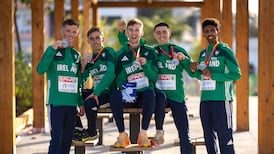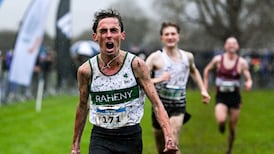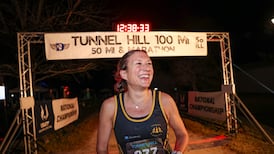There is no quick or easy way to access Sophie O’Sullivan in college in Seattle. These are busy days in the life of the student athlete, now in her senior year, more so with next summer’s Paris Olympics already in mind. No time to lose.
So somewhere in between the eight time zones and her full-on schedule she suggests a possible slot around noon, her time, when it turns out she’s in the gym doing some core exercise work. “I’ll be good to talk then,” she says.
With so much to talk about – and by Irish standards O’Sullivan’s giant strides on the track this summer are arguably second only to Rhasidat Adeleke, her European Under-23 gold a first by any Irish athlete – it’s important to get straight down to business.
“So how is the weather up there these days?”
READ MORE
That’s not a vacant question. No place on earth has a greater fascination with the weather than the seaport city of Seattle, and the University of Washington lies at the heart of it. It’s said there are only two seasons (wet and dry), it’s better to look at the sky than the forecast and there’s a spare umbrella left on every street corner.
Just 100 miles south of the Canadian border, the largest city in the Pacific Northwest, Seattle is also popularly known as the home of Amazon, Starbucks, grunge music and it’s been O’Sullivan’s home for the last three and a half years. Sophie’s first choice, so to speak.
By coincidence, I’ve been rereading The Boys in the Boat, ahead of its big cinema release next month, George Clooney directing the incredible true story of the men’s eight rowers from the University of Washington, representing the USA at the 1936 Olympics in Berlin, who narrowly beat the German crew in full view of Adolf Hitler.
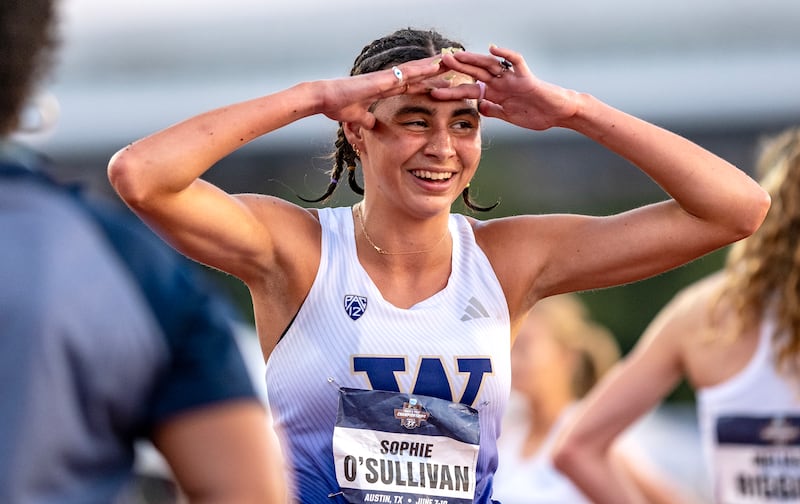
The book is fascinated with the weather too – the Washington crew regularly train through tortuously bleak rain, fog, hail, snow and that’s in the month of June. Before being known as the Huskies, the University was known as the Sun Dodger and without the glorious ending it would put most off living anywhere near Seattle.
“That boat is actually hanging over our dining hall here,” O’Sullivan tells me. “I definitely feel like I should read the book before the movie comes out, I keep meaning too, so I’m a bit behind.
“The weather’s actually not been bad lately. Very autumnal at the moment, I think with the super El Niño or something, is nicer than it usually is, it hasn’t been as cold this year.”
No time to lose. How O’Sullivan ended up living and studying in Seattle, the now 700-acre campus at the university, with around 50,000 students, one of the oldest and largest on the west coast, is a curious story in itself. Particularly given there’s no tradition of Irish distance running there (and no hugely famous athletic alumni either beyond Hope Solo and Bruce Lee).
Unlike on the east coast and particularly Villanova, where her mother Sonia went to college, following in the footsteps of Ronnie Delany, Eamonn Coghlan, Marcus O’Sullivan, among many others. Or she might well have preferred to study in Melbourne, where she was born and raised, with the guarantee at least of warmer weather.
“Honestly, I didn’t really speak with many other schools. I don’t think I was even 18 when I came on my visit here, thought ‘this is great’. That was enough for me, really. I just liked it, the coach Maurica Powell here is great.
“I met Gina [Procaccio], the coach from Villanova, we got on very well. Whenever I see her now, we still get on well, but I’m happy with where I ended up, how it worked out. I mean it is a beautiful campus, and a really nice time of year right now.
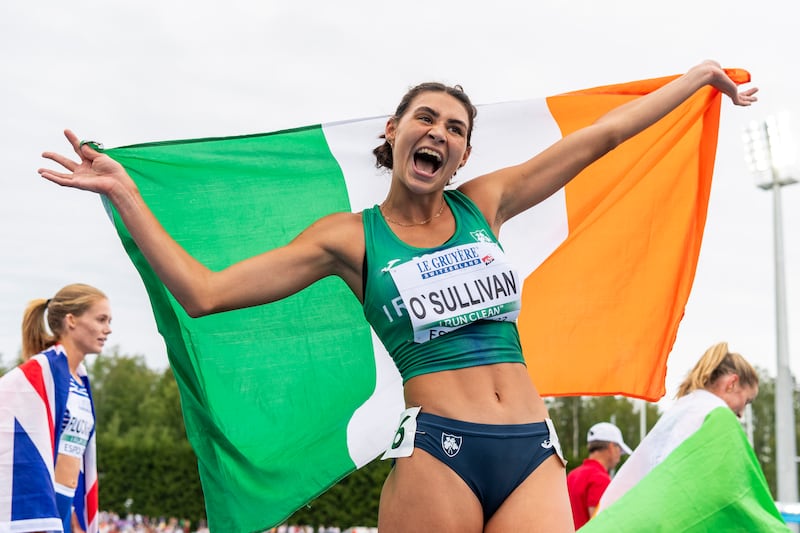
“I live with three other girls on the track team, two girls from the US, and one Australian girl, Elle Rutherford. The team as well has definitely built up over the last year or so. A few people left, we’d a lot of new freshman, this year they’re second or third year, so it all feels a lot more settled, and the team environment works really well this year.”
Their immediate goal is the climax of the college cross-country season, the NCAA Championship set for Charlottesville, Virginia next Saturday. O’Sullivan, still 21, has been making strides there too. She was their top finisher, in sixth, when winning the Pac-12 Conference cross-country last month, for only the fourth time in Washington’s history (and the last, given they’re moving to the Big Ten Conference next year.)
Just like her mother at Villanova (keeping inevitable comparisons to a minimum) O’Sullivan also took some time to adjust to college life in America and likewise endured a stress fracture in her first year. When she started in August 2020, the world was still reeling from the global pandemic and she was understandably race rusty.
“I think my first year here, it was all new, quite amusing. A bit like being on holiday in America. Then towards the end of the first year, into the second year, you think ‘I actually live here’, you have to start to work out what you’re doing, it’s not a holiday any more.
“So yes, it just took some working out. But also I didn’t really run much the year before I came here, because it was a Covid year. I was training by myself, and when I was 17, I wasn’t very good at that. I’m better at it now. But I think then it was like ‘yeah I’m training, doing all the stuff’, but I really wasn’t doing anything. I was only running a few times a week, an hour or so, with maybe one session.
“Then I came over here, thinking I was more of an 800m runner. But that wasn’t true, I just needed to do a bit more [training]. When I was doing well in school, I was also playing a lot of basketball and soccer, but running a fair bit too, and just didn’t really know it. So it was just about finding your feet after all that.”
She’s spoken before about those teenage years growing in Melbourne, when at times she wanted “nothing to do” with any talk about being the daughter of Ireland’s greatest ever women’s athlete. And that she had a father too, in O’Sullivan’s husband Nic Bideau, one of Australia’s foremost distance-running coaches and now elite running managers. She’s never been coached by either.
Both do help prove the old theory that the single most important factor in athletic success is choosing your parents wisely. Either way, it would also be Sophie’s choice to represent Ireland – given she holds dual citizenship – before she soon started to make a name for herself.
In 2017, at age 15, she won the Irish Under-17 1,500 title (same as her mother did, 32 years before), and on her 16th birthday that December, she ran a breakthrough time of 2:06:29 for 800m. The following summer at the European Under-18 Championships in Gyor, Hungary, her first in an Ireland vest, she won 800m silver in 2:06;05, beaten only by Britain’s Keely Hodgkinson, the now Olympic and two-time World Championship silver medallist.
Gyor also helped introduce Irish athletics to Adeleke, who won the 200m gold at age 15, along with Sarah Healy, who won a brilliant 1,500m/3,000m double. Adeleke’s trajectory continued to rocket, Healy’s to some extent too, only for O’Sullivan it hit something of a plateau.
“I think it’s probably a bit different with the sprints, a different kind of intensity I guess, building more intensity than building miles. With Rhasidat, whenever we met at races, we’re always excited, and whenever she does well, I feel she works really hard, really deserves it, so you’re always really happy to see it.”
She’s clearly considerate about her thoughts, not afraid of being occasionally more decisive too. There were some telltale signs O’Sullivan’s trajectory was about to rocket again, starting with last season’s NCAA cross-country, when she went from 244th, in 2021, to 73rd.
Indoors, she was part of the University of Washington team which broke the NCAA record in the distance medley relay, by nine seconds, and outdoors she quickly improved her 1,500m best from 4:17:54 to 4:08:06, later making the NCAA 1, final, which didn’t go to plan, but provided vital experience nonetheless.
In her next race, her senior debut at the European Team Championships in Silesia, Poland, she helped Ireland earn promotion to the second tier by winning the 1,500m, thanks to searing 59-second last lap.
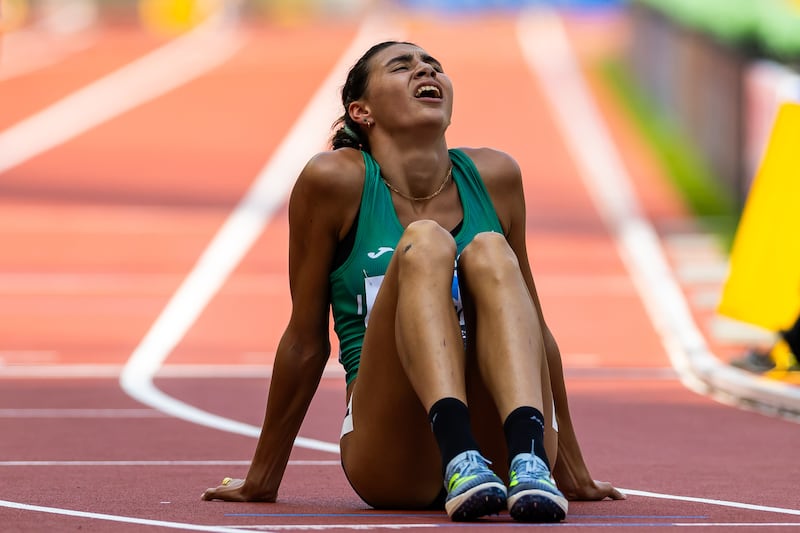
From there, after winning an Irish Under-23 800m/1,500m double, she went to the European Under-23 Championships in Espoo, Finland, ranked second to Sarah Healy, who had run some seven seconds faster than anyone in the grade.
Intent on making it fast, Healy led all the way until the final bend, before O’Sullivan unleashed her finishing kick (also so reminiscent of her mother), winning in another lifetime best of 4:07:18, Healy never gave up the chase and nailing silver in 4:07:36.
“For the European Team Championships, I got an email about that, a few weeks out. I know it was a lower division, and a few people didn’t want to run it. But I thought it would be fun to do and that I might win it. And if you can win something you should always do it.
“With the Under-23 Championships, I’d no idea how it would go, there was no real expectation, so I wasn’t worried about running this time or anything. I just thought I’ll keep up as long as I can and if I’m still there, I’ve got a shot on the last lap.
“I just remember the support from everyone on the team, and how excited everyone else there was. I wasn’t expecting so much excitement, so I did a little [victory] lap after, thinking ‘I’m definitely going to do one of those’. So it just started with that and kept going with new goals, into the season, this race, then that race.”
Indeed she did. After finishing second to Healy in the National 1,500m, she went to Bern in Switzerland and ran 2:37:08 for 1,000m, only her mother (2:34:66) and Ciara Mageean (2:31:06) faster on the Irish all-time list. She also secured a quota qualifying spot for the World Championships in Budapest, narrowly missing out on the semi-finals when finishing eighth – some compensation though in running another five-second lifetime best of 4:02:15, an automatic qualifying time for Paris.
“No, definitely not,” she says, when asked if that sort of time was in her head. “The thing is I wouldn’t really be setting times to begin with, I’d be more into picking an event, say make the NCAA final. So I’d focus on the season first, like that. You might have some time in the back of your head, but I’d be more into focusing on what is directly in front of you first, like ‘I want to win this race!’

“I hadn’t really raced heats before, outside the NCAAs, so I’d no idea how that was going to go. But I’ve never really been particularly time-inclined, no, I’m just not very good with that kind of thing,”
Just like her mother’s preferred way of racing too, by the way, there’s no denying there are occasions when they do talk running, particularly with O’Sullivan based for much of the season in the neighbouring state of Oregon, assistant coach at the Nike Union Athletics Club.
“She was just here last weekend for a few days, is mostly based in Portland and it’s nice to have someone like that close. For sure, she’s always there for a word of advice. I think just like anyone else, whenever they’re making a choice about something, whether they know a lot about it or they don’t, you call home and you ask them what do they think?
“Okay, the fact she’s done some of the stuff that I’m doing, she does know a little bit about it. So she can be like ‘well I tried this ...’ But I think that’s the same with any big decision.”
No time to lose. She turns 22 next month and has made other choices of her own, majoring in journalism (“I am, yeah, so if you need anyone!”), and there’s a clear enjoyment about her running that all augers well for her future.
“If you at least start, and finish, with a smile, you’re going to be already winning something. It’s much better that way. If you start in a bad mood, you’ve got no shot. It’s not all that serious in the end, if you think about it. Just a few of us out for a run, it doesn’t haven’t to be a big stressful or scary thing.”
The Paris Olympics will soon be looming, another big step up for 2024 and the life of the student-athlete.
“I’m thinking that less so, maybe the people around me more so. For me, it’s all the little pieces, do the best I can for the team in cross-country, and that’s also going to help me get fitter in the long run.
“I’m also going to go back to Australia for Christmas. Then back for indoors, which will be a shorter season, but indoors is already kind of quick season in the end. But it will be nice to get some proper summer, in Australia, maybe drag that out a little more. Just to run in the warm a little longer.”
All athletes are naturally fascinated with the weather.





